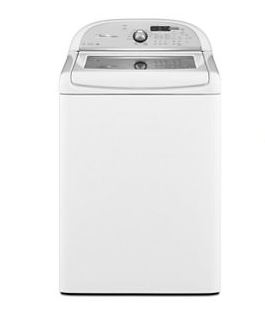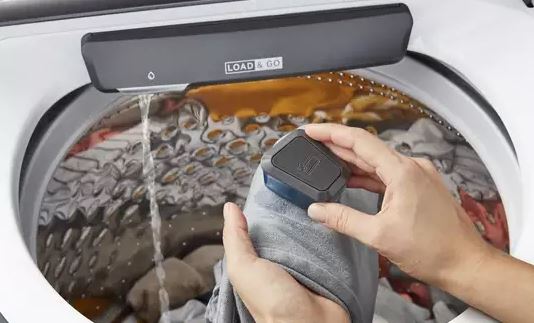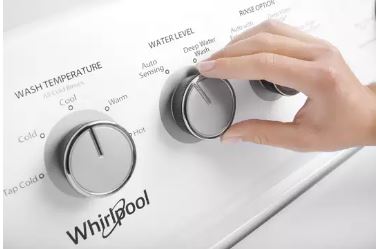Ideally, you expect your washing machine to go into a sensing phase for about 2-3 minutes as it fills up with water. But what if you have a Whirlpool Cabrio washer stuck on sensing mode for 5 minutes or more? What could be wrong?
Your Whirlpool Cabrio washer might be stuck on sensing due to a load imbalance, wrong setting, clogged drain, or a faulty component like the lid switch, water inlet valve, shift actuator, sensor, drive belt, control board, or motor.
While your washer must go into the sensing phase to determine the load size, weight, and balance to match it with the correct amount of water needed, it should only take 3 minutes or less.
This guide shall discuss all the ten reasons why your Whirlpool Cabrio washer gets stuck on sensing and the fixes to attempt.
Here we go!

In a rush? Below are the ten likely explanations for your Whirlpool washer not going beyond sensing mode and the fixes:
Quick Troubleshooting Guide for a Whirlpool Cabrio Washer Not Sensing
| – | Probable Reason | Possible Fix |
| 1. | Load Imbalance | Redistribute the laundry in the washer evenly |
| 2. | Wrong Setting | Ensure you choose the correct settings to match your load size and type |
| 3. | Clogged Drain | Unclog the filter, drain hose, or pump in case of clogging |
| 4. | Faulty Lid/Door Switch | Test the switch’s continuity and replace it if it shows no continuity |
| 5. | Faulty Water Inlet Valve | Unkink the valve if kinked, clear any error code, and replace the valve solenoid if it lacks continuity |
| 6. | Defective Shift Actuator | Replace the shift actuator if it is defective |
| 7. | Faulty Sensor | Calibrate your washer to clear any sensor fault |
| 8. | Defective Drive Belt | Tighten the belt in case of any misalignment and replace it if damaged |
| 9. | Bad Control Board | Replace the control board if it is defective |
| 10. | Motor Fault | Replace the drive motor in case of damages |
Why Is My Whirlpool Cabrio Washer Stuck On Sensing?
Below are the ten possible reasons why your Whirlpool Cabrio washer gets stuck on sensing mode and their fixes:
1. Load Imbalance
The sensing mode may stop prematurely or take longer enough because of a load imbalance. This is because your washer must accurately determine the load weight and its balance to ensure it receives enough water.
If the load is out of balance, your washer will find it hard to tell the load size and weight, and could be why it overstays in the sensing mode.
Possible Fix
Stop your washer, distribute the laundry evenly, and reset your washer before restarting it.
2. Wrong Washer Setting
You confuse the washer if you fail to select anything or choose the wrong wash setting at the control panel. Consequently, it remains on sensing until you select the correct settings.
Possible Fix
Choose the correct settings in the control panel to match your load size and type.
3. Clogged Drainage
Before a wash cycle starts, your washer must ensure no drainage issue. If it senses any blockage in the drain filter, hose, or pump, it will remain in the sensing phase until you solve the problem.
Possible Fix
Clean the filter with running tap water. Check deeper into the drain hose and pump, and use a drain snake to unclog the hose and pump in case of clogging.

4. Faulty Lid/Door Switch
A malfunctioning lid/door switch is also a potential cause of a sensing issue. The switch ensures the washing machine does not start a wash cycle until the door or lid is engaged correctly.
Your washer will stay in sensing mode if the faulty switch does not recognize a closed door/lid.
Possible Fix
Test the switch’s continuity using a multimeter and replace it if it’s faulty.
5. Faulty Water Inlet Valve
The water inlet valve gets signals from the control board to fill the washer with water. During your washer sensing phase, it can determine the water needed to wash the given load.
However, the inlet valve may malfunction and won’t enable the right amount of water to enter your washer as specified by the control board.
Sometimes, this occurs when the inlet valve is clogged or kinked, when there’s a loose connection or damaged wires, or when the valve fails to open fully.
It could also happen if the solenoids start to struggle, which you can quickly identify if you hear a hissing sound from the inlet valves.
Possible Fix
You can do a visual examination or electrical testing on the inlet valve. Physically examine if the valve is restricted or if there are any signs of wear.
You can also perform a diagnostic on your Whirlpool Cabrio washer to check for related error codes. If there’s any clogging on the inlet valve, clean it, and in case of an error code, clear it.
Electrically, test the solenoid’s continuity using a multimeter and replace the entire water inlet valve if it shows no continuity.
6. Defective Shift Actuator
In most cases, the shift actuator is usually the part to blame when your Whirlpool Cabrio washer sticks on sensing. It’s the part that moves the washer from agitating to spinning.
If this part is faulty, the washer drum won’t move during sensing, thus making it hard for the washer to determine the load size and weight. That could be why your washer is stuck on sensing.
However, it’s easy to diagnose a bad shift actuator. One, you can tell if it’s faulty if the washer doesn’t spin during the sensing phase. Secondly, if there are clicking or grinding noises, it’s evident that the actuator is trying to engage the transmission to no avail.
Possible Fix
Check out the shift actuator at your washer bottom, do a keen visual examination to check for signs of damaged wires, burned parts, corroded electrical connections, or broken pieces, and fix the individual components.
You can also check for possible shift actuator-related errors at the display panel and fix them accordingly.
7. Defective Sensor
Once your washer enters sensing mode, it uses the sensors to know the size load, weight, water temperature, and water level. Each sensor must be calibrated to ensure it gives accurate readings.
If any sensors aren’t calibrated, your washer will stick into sensing. But you may wonder, how would you know that a sensor isn’t calibrated well enough?
Below are a few signs:
- The washer displays sensor-related errors
- There’s a slow water fill to the washer
- There are issues with the water temperature
- Your Whirlpool Cabrio washer is a new

Possible Fix
To fix a sensor-related issue, you need to calibrate your washer, which may differ from one Whirlpool model to the other. However, below is how to perform a Whirlpool Cabrio washer sensor reset:
- Disconnect your washer for about 3 minutes and plug it back
- Turn the cycle selector knob to Normal
- Rotate the knob counterclockwise (full 360 degrees) and set it at Normal position again
- Pause for at least 3 – 4 seconds
- Turn one click to the left, three clicks to the right, a click to the left, and one more click to the right
- Turn the selector knob four clicks to the right and wait for only the rinse LED light to light up, and then hit the start button
- The washer will go into recalibration mode, which may take up to 3 minutes, and the sensor issue should immediately clear.
8. Faulty Drive Belt
During sensing, the washer tub/drum moves for the load size to be determined and matched with the right amount of water. The drum moves with the help of the drive belt.
If the belt is defective, the drum won’t spin. Hence, your washer won’t start but sticks to sensing mode.
But how do you tell you are dealing with a bad drive belt?
You can use your ears and nose. Take note of any burning smell or loud noise from your Whirlpool washer.
Also, you can physically examine the belt for wear and tear, stretchiness, cracks, misalignment, or breakages.
Possible Fix
In case of a misalignment, try tightening the belt, but if the inspection reveals any damages or wear, replace the drive belt.
9. Defective Control Board
Another part that is hugely involved in sensing is the control board. The control board is like the washer’s brain that controls nearly all the functions during sensing.
However, a defective control board will not send the signal to allow the sensing mode to complete; thus, it gets stuck.
This could happen when there’s a miscommunication between the washer control board and other parts like the motor or sensor or a software glitch.
Possible Fix
Truthfully, the control board is the most challenging part to test and fix. However, you can start by checking possible control board-related errors on the display and then clear them.
Then, conduct a physical examination for damages, loose connections, blown capacitors, or burnt marks and fix them accordingly.
You can also use a multimeter to test the fuses, capacitors, and relays for continuity and replace the faulty part. If that doesn’t work, try and reset the washer, but if nothing seems to work out, replace the entire control board with the help of an expert.
10. Motor Issue
Your last resort should be to check out the motor. Though unlikely, the drive motor can also get your Whirlpool Cabrio washer to stick on sensing mode.
If the motor has issues, the washer drum won’t move. An overheating motor, damage, or loose connections could cause your washer to stick on sensing.
You can visually examine the motor for damages, measure the resistance across the motor windings, or test the bearings when spinning the motor shaft with your hand.
Possible Fix
If the issue lies in a faulty connection, you can quickly fix the problem. However, if there’s damage on the windings or the motor is worn out, there’s no shortcut around it but to replace the motor.
Concluding Remarks On a Whirlpool Cabrio Washer Stuck On Sensing
Now you know why your Whirlpool Cabrio washer gets stuck in sensing mode. The sensing phase is necessary to determine the load size, weight, balance, and water level, but it should not exceed 3 minutes.
If it does, it could be due to a load imbalance, wrong setting, clogged drain, faulty lid switch, faulty water inlet valve, defective shift actuator, faulty sensor, defective drive belt, bad control board, or motor issues. You can use the guide above for easier troubleshooting.
Also Read:
